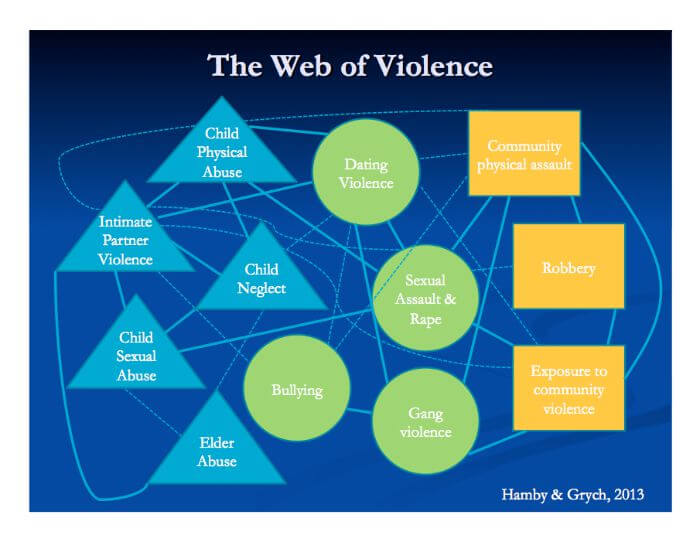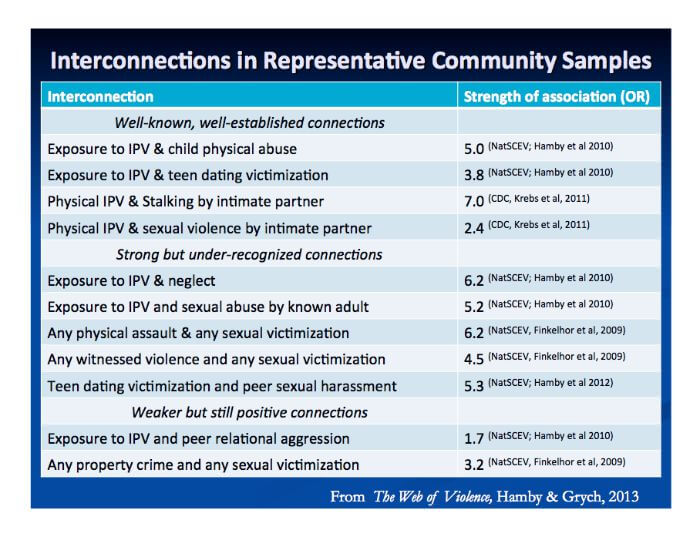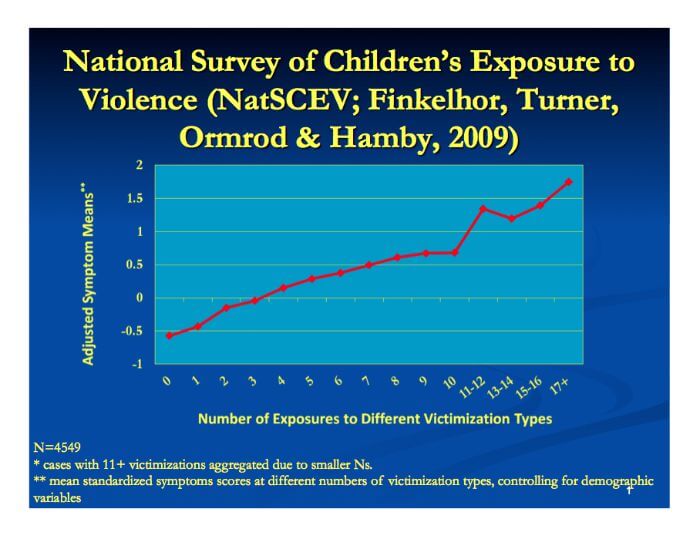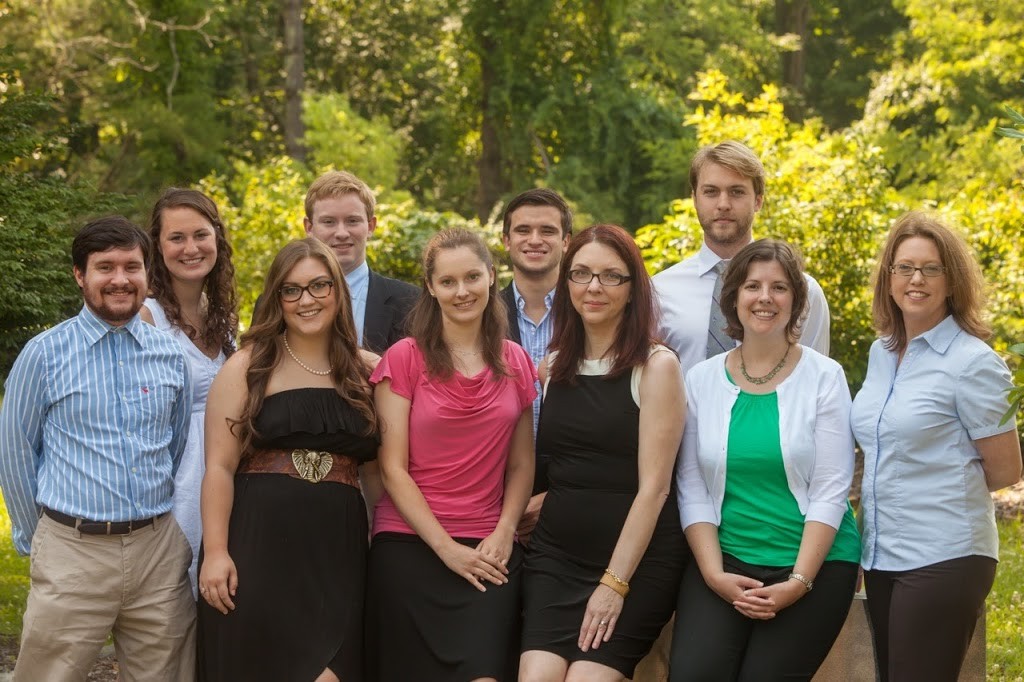Sherry Hamby, Ph.D.
Did you know that 11% of children have 5 or more different types of victimization exposure in one year?
According to the National Survey of Children’s Exposure to Violence, these children (often referred to as “poly-victims”) have the type of victimization most associated with mental health difficulties. It is only through proper assessment, that assistance can be provided to these children in a timely manner.
There appear to be four distinct Pathways to Poly-Victimization:
- living in a dangerous neighborhood
- living in a dangerous family
- having a multiproblem family environment, or
- having emotional problems that engender antagonism, increase risk behavior and compromise one’s ability to protect oneself.
To learn more about this subject, Social Work Career Development reached out to Dr. Sherry Hamby, an expert on the topic of poly-victimization. Dr. Hamby is co-investigator on the National Survey of Children’s Exposure to Violence and the author [or co-author] of more than 100 works including The Web of Violence: Exploring Connections Among Different Forms of Interpersonal Violence and Abuse.
Sherry Hamby is also a Research Professor of Psychology at the University of the South and the founding editor of the journal Psychology of Violence. As a licensed clinical psychologist, she has worked for more than 20 years on the problem of violence, including front line work, crisis intervention, therapy and research.
Without further ado, Sherry, could you please tell us a bit about your background and how you specialized in polyvictimization?
I am a clinical psychologist by training and have spent most of my professional career working to address the problem of violence. The longer I have been in the field, the more it has become apparent to me that we need to understand how all of the different forms of violence relate to each other, not just what is going on with individual types.
More personally, I specialized in violence and victimization because I have seen how much suffering has caused for family members and loved ones. I think violence and aggression are the root cause of most psychological distress.
Could you explain in laymen’s terms what is polyvictimization and polyperpetration?
Polyvictimization means experiencing multiple types of violence, usually in multiple settings and at the hands of multiple perpetrators. We often speak of bullied children versus abused children, for example, but the reality is that these are often the very same kids getting victimized at home and in the school.
The same goes for perpetrators—we talk about robbers and rapists and bullies as if those are different groups of people, but in many cases those are the same offenders committing multiple different types of offenses in different settings in different relationships across the lifespan.
 The Web of Violence – all forms of violence are interconnected.
The Web of Violence – all forms of violence are interconnected.
How does polyvictimization differ from complex trauma?
Polyvictimization has similarities to complex trauma. They both focus on the experience of multiple adversities. There are two key differences.
1. Polyvictimization emphasizes the importance of “everyday trauma”—the bullying, verbal aggression, and minor physical assaults that all impact our well-being just as much as full-scale disasters do.
2. Polyvictimization emphasizes interpersonal violence, not natural disasters or other unintentional adversities. We certainly recognize that other bad events, ranging from floods to unemployment, can cause huge upheavals for individuals and families, but we emphasize the violations of social norms, the betrayals of interpersonal trust, and the intentional maliciousness of violence.
How does polyvictimization impact youth assessment? And what are your thoughts about trauma-informed treatment?
We think it is essential that mental health professionals start widening their lens. The safety and well-being of our clients is the number one goal of virtually all of work and we need to start systematically assessing safety across all domains.
We prefer the term “victimization-informed care.” Trauma-informed care is a very useful concept, but by emphasizing trauma, the concept emphasizes extreme events and the open expression of symptoms.
In the latter case, men of most cultures and all members of some cultures are less likely to be identified as needed trauma-informed care.
See our websites for more information:
http://www.unh.edu/ccrc/jvq/
This site has a toolkit to help assess the full extent of victimization experienced by youth.
http://www.nationalcac.org/calio-library/polyvictimization.html
This site has a number of excellent of resources on the topic including a free on-demand webinar on how to assess polyvictimization and tips on how to provide victimization-informed care.
 An illustration of how strong the interconnections among forms of violence are, even for some forms that we usually think of as distinct from each other.
An illustration of how strong the interconnections among forms of violence are, even for some forms that we usually think of as distinct from each other.
In the ACEs (Adverse Childhood Experiences) study, we learned that children who experienced 4 or more categories of adverse experiences were more likely as adults to suffer from mental health and/or substance issues. How do the risks from polyvictimization compare to the risks that stem from the ACEs study?
The ACEs study also emphasizes the cumulative effects of trauma. The main differences are that we assess a much wider range—we have a recent paper showing that the ACE items may not even be the most important ones.
Our analyses indicate that although the ACE items are associated with mental health symptoms, others were even better predictors: peer rejection, peer victimization, community violence exposure, school performance, and socioeconomic status.
As mentioned previously, we emphasize violence over other forms of adversity. The ACE study is more like complex trauma. We will be looking at physical health outcomes also in our new study.
 This shows cumulative effect of victimizations on mental health.
This shows cumulative effect of victimizations on mental health. Other analyses show that so-called “minor” victimizations such as bullying or sibling violence add to psychological distress in ways that are surprisingly similar to more serious victimizations.
While it is true that adults who experienced either higher adverse childhood experiences or polyvictimization as children are at greater risk for suffering from various mental health and health issues as adults, isn’t it also the case that there are also adults [and children] who manage to transcend their environment and traumas? To what do you attribute their resilience?
This is a terrific and important question and in fact is the focus of a new project I am conducting with John Grych and Victoria Banyard. Resilience is the norm, not the exception, although resilience does become less likely with each additional victimization.
We believe that the current evidence suggests that certain individual strengths: good interpersonal skills, good regulatory strengths (such as impulse control and emotional regulation) and a focus on meaning-making help people overcome adversity. Strengths in one’s family and one’s community also play a key role.
What are some things that we can do to increase our resilience?
The great news about resilience is that we can all get better at it. One method we are looking at in our new study is emotional, autobiographical storytelling.
We think especially sharing your story with a trusted teacher, therapist, or group is healing and transformative. Focus on the actions that build meaning into a life—maintaining relationships, finding a cause to support.
Sherry Hamby with her Life Paths Research Program staff, who are conducting new research on resilience after adversity at the University of the South
If you were to divide your time between your different roles of researcher/psychologist/editor about how many hours or what percentage of your time, do you spend on each of your roles per week?
I spend the biggest chunk of time on research—maybe 40% of my week. That includes collecting data, analyzing data, writing, and presenting at conferences and other meetings.
Editing the journal is also a big chunk, perhaps 20%. During the school year I teach a class in the spring and fall, maybe 15%.
The other 25% I spend on everything else—grants management, email, and, of course, doing interviews for blogs! I am not currently providing any direct services, although we do provide a lot of referrals for research participants and I advise students.
What are the parts of your work that you find most enjoyable?
I love seeing students get excited about research for the first time. I enjoy getting out into the field. We are collecting data in my current home, in a rural part of Appalachia, at the moment and it has made me realize how much I miss being out in the community. These days I spend too much time in the ivory tower of the college campus!
I really enjoy editing the journal—sometimes I feel as much pride in shepherding other people’s work along as I do in my own. And of course there is nothing like the feeling of figuring out a scientific challenge for the first time.
And what aspects are the most difficult/challenging?
I love editing the journal, but it has challenging aspects. It is not easy to reject papers, especially when I know most of them involved a lot of effort by the authors. I hope authors find the comments helpful but I know a rejection is never the decision anyone wants.
As any of your readers who have done research know, the research process involves a lot of delayed gratification and that can be frustrating.
It is also challenging to organize one’s time when the day is not broken up into therapy appointments, classes, or other obvious segments.
Lastly, what career advice would you offer mental health recent graduates contemplating pursuing a Ph.D. in a mental health related field?
Completing the dissertation is the biggest stumbling block for finishing a Ph.D. Almost everyone who starts a doctoral program has the coursework down. So the number one piece of advice I usually give people is to get some research experience. These days, the faculty of most PhD programs have figured this out too and it is very difficult to get into a doctoral program without any research experience.
It is also important to get at least a little experience in a clinical setting so you can see if that is really something you like.
Finally, letters of recommendation are important and the way to get good ones is to get outside of the classroom. Complete an independent study or internship—something that gives a professor or provider the chance to say more than “received an A on the midterm.”
I would like to acknowledge the contributions of my colleagues to the work I have discussed here: Victoria Banyard, David Finkelhor, John Grych, and Heather Turner. Thank you for the opportunity to discuss all of these issues.
Thanks so much, Sherry, for providing us with this valuable introduction to polyvictimization !
You may follow Sherry on twitter at @Sherry_Hamby
Did you enjoy this post? If yes, would you please “like” and/or share it with others? Thanks!




Dorlee, thank you for sharing this post on polyvictimization. It’s a great reminder for me and others to do a thorough job of assessing victimization.
Sherry, thank you for sharing your research with us, too!
Thank you, Tamara for your kind comment 🙂
I am most grateful to Sherry for her taking the time to bring us all up-to-speed with the latest in the area of victimization so that we have a better chance of providing “victimization-informed care.”
Hi, Dorlee–
Excellent interview—thank you for the post. Polyvictimization is one of those concepts that more social workers need to be aware of. I’ll be curious to read more about this in the coming years, especially as more doctoral students incorporate the idea into their research. I’m betting that it will have a huge impact on how we work with clients.
Thank you, MTB
I’m so glad that you found this interview helpful.
By the way, this month [September] as well as in the next upcoming months, a number of different webinars addressing various components of Polyvictimization will be provided.
For this month’s webinars on Polyvictimization, please see http://www.dorleem.com/2013/09/mental-health-webinars-for-you.html%5D.